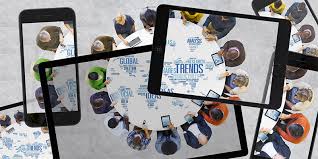The Power of Graphic Communication
Graphic communication is a powerful tool that combines visual elements with messaging to convey information effectively. From logos and branding to infographics and advertisements, graphic design plays a crucial role in capturing attention and communicating messages in a visually appealing way.
One of the key advantages of graphic communication is its ability to transcend language barriers. Through the use of symbols, colors, and images, graphic design can convey complex ideas and emotions without the need for words. This universal appeal makes it an invaluable tool for reaching diverse audiences across different cultures and languages.
Furthermore, graphic communication enhances brand recognition and recall. A well-designed logo or visual identity can help a company stand out in a crowded marketplace and create a lasting impression on consumers. Consistent use of visual elements across various platforms reinforces brand identity and fosters customer loyalty.
In today’s digital age, graphic design plays a vital role in online marketing and social media engagement. Eye-catching graphics are essential for capturing users’ attention amidst the sea of content available online. Whether it’s through social media posts, website banners, or digital ads, compelling visuals are key to driving engagement and conversions.
Overall, graphic communication is an essential component of effective storytelling. By combining creativity with strategic messaging, graphic designers have the power to evoke emotions, convey information clearly, and leave a lasting impact on their audience. In a world where visual content reigns supreme, mastering the art of graphic communication is more important than ever.
5 Essential Tips for Effective Graphic Communication
- Use simple and clear visuals to convey your message effectively.
- Choose a color scheme that enhances readability and visual appeal.
- Utilize white space to improve overall design aesthetics and focus.
- Maintain consistency in fonts, styles, and graphics for a cohesive look.
- Consider your target audience when designing visuals to ensure relevance and engagement.
Use simple and clear visuals to convey your message effectively.
When it comes to graphic communication, a fundamental tip is to utilize simple and clear visuals to convey your message effectively. By keeping your designs clean and uncluttered, you can ensure that your audience easily understands the information you are trying to communicate. Simple visuals not only enhance readability but also help in capturing attention and leaving a lasting impression on viewers. Remember, clarity is key in graphic design to ensure that your message resonates with your target audience.
Choose a color scheme that enhances readability and visual appeal.
When it comes to graphic communication, selecting a color scheme that enhances both readability and visual appeal is paramount. The colors used in design play a crucial role in conveying emotions, guiding the viewer’s eye, and creating a cohesive visual experience. By choosing colors that not only complement each other but also contrast effectively, designers can improve the readability of text and make key elements stand out. A well-thought-out color scheme can enhance the overall aesthetic of a design while ensuring that the message is communicated clearly and effectively to the audience.
Utilize white space to improve overall design aesthetics and focus.
Utilizing white space is a crucial tip in graphic communication to enhance overall design aesthetics and focus. By strategically incorporating empty spaces around elements, text, and images, designers can create a sense of balance, clarity, and visual hierarchy in their designs. White space allows the eye to rest, improves readability, and directs the viewer’s attention to key elements of the composition. Embracing white space not only adds elegance and sophistication to a design but also contributes to a more engaging and impactful visual experience for the audience.
Maintain consistency in fonts, styles, and graphics for a cohesive look.
Maintaining consistency in fonts, styles, and graphics is a fundamental tip in graphic communication that ensures a cohesive and polished look across all design elements. By using the same set of fonts, color schemes, and visual motifs throughout a project, designers can create a sense of unity and reinforce brand identity. Consistency not only enhances readability and visual appeal but also helps establish a strong visual hierarchy that guides the viewer’s attention. Whether it’s a website, marketing collateral, or social media campaign, adhering to consistent design elements is key to creating a professional and harmonious visual presence.
Consider your target audience when designing visuals to ensure relevance and engagement.
When delving into graphic communication, it is crucial to consider your target audience during the design process. By understanding the preferences, interests, and demographics of your audience, you can tailor visuals that resonate with them effectively. This approach ensures that your designs are not only visually appealing but also relevant and engaging to the specific group you are trying to reach. Keeping your target audience top of mind when crafting visuals allows for a more personalized and impactful communication strategy that fosters connection and interaction with your intended viewers.


